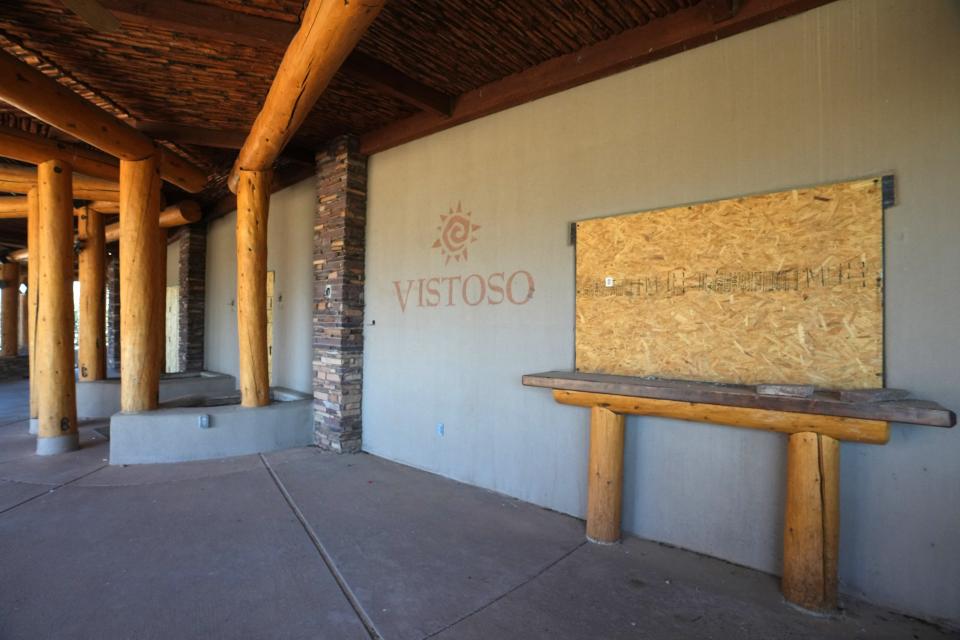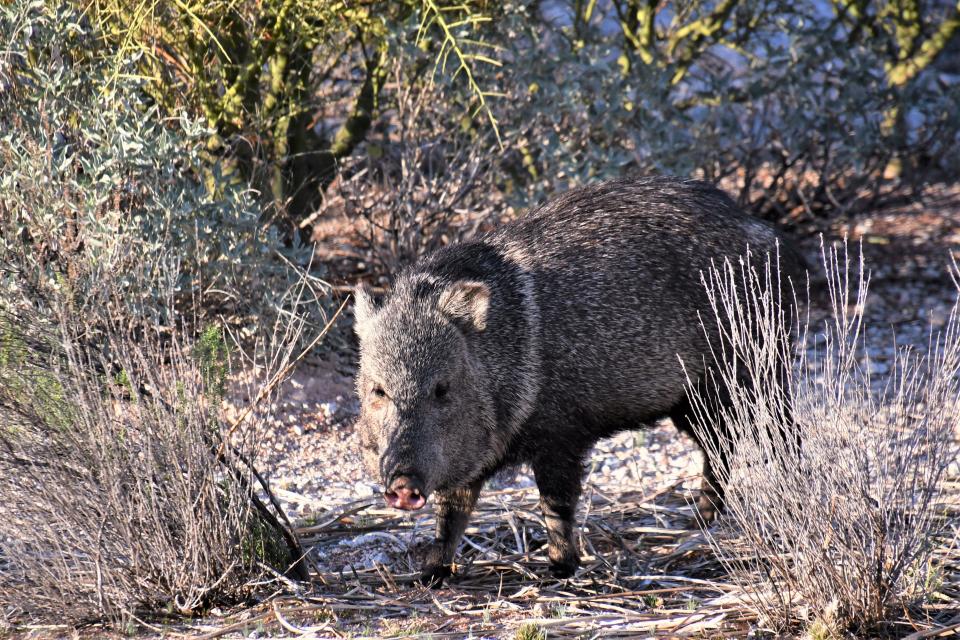After a golf course closes, neighbors raise the money to preserve the open space
ORO VALLEY — The Rancho Vistoso golf course teemed with life.
Situated a few miles north of Tucson, it stretched across more than 200 acres and was visited by golfers during the day and mule deer and javelina at night.
Famed golf course architect Tom Weiskopf designed it as a desert course. If it weren’t for the golfers and the signs, it might almost have resembled a desert botanical garden at times. Cholla, barrel and prickly pear cactuses encircled signs for the driving range and holes. Palo verde and mesquite trees and other desert vegetation grew scattered throughout the greens.
The course meandered through 17 neighborhoods. Town residents held parties and weddings at the clubhouse, and those who didn’t attend could sometimes still hear the music’s echo from their houses.
But when the course closed in 2018 and the water was shut off, the thirsty greens began to fade.
It didn’t take long for speculation about development to spread among Oro Valley’s residents and a year and a half later, the redevelopment plans began rolling into the city council office.
Some suggested housing developments, another a nursing home. Several neighbors cringed at the thought of bulldozers near their homes and the loss of an open space abundant with native plant and animal species. They wanted the golf course to become a nature preserve.
So they got to work. Over the next three and a half years, they would speak with land transaction lawyers and send over 1,000 emails to the city's planning and zoning department. Eventually, they raised $1.8 million and worked with the Conservation Fund to purchase the property.
With the money, the group and the fund were able to create the town's first nature preserve.
♦ ♦ ♦

While the council and developers considered alternatives, many neighbors had already decided the former golf course was a preserve. They started — illegally — traversing the 208-acre property by foot, on bikes, with dogs and strollers.
“People just took to it. It was like an organic process,” said Rosa Dailey, whose house is next to the golf course. “It was private property, but people were like, ‘No, this is a park!’”
The 18-hole course had closed in 2018 from financial problems. Golf courses operate on small profit margins, usually about 2-4%, according to Ed Gowan, executive director of the Arizona Golf Association. Rising management costs had tipped the course into an unsustainable business model and Canadian lender Romspen reclaimed it after its owner defaulted on the mortgage.
The course shut off the water that year. But in the three-and-a-half years that followed, something marvelous happened, according to Dailey. The greens were no longer green, with invasive grass species overtaking them, but she saw more deer and birds than ever before.
Now, Dailey says, the neighborhood fawns use the course’s former sandpit as a playground.
♦ ♦ ♦

In Oro Valley, a small town minted in 1974, you have to get involved in the community, Dailey said.
“I've never been involved in community stuff in any other community I've ever lived in. But in Oro Valley, you’ve got to get involved,” she said. “You have to say this is what I want, because if you don't, opportunists come in and they try to make money off of the beauty here. And they don't necessarily like the community, they just like the ability to make money.”
Dailey followed her parents from Baltimore to Oro Valley 15 years ago when they decided to retire there. She and her husband raised their two daughters, who have since left to attend the University of Arizona, in the town.
After the closure of the golf course, Dailey and a few other neighbors started an organization to fight development offers. They called the organization Preserve Vistoso and applied for and received 501(c)3 non-profit status.
They educated themselves, Dailey said, reading up on conservation law. They spoke with their neighbors and different lawyers. They attended city council meetings virtually, per pandemic rules. The former golf course was zoned for recreational open space and for developers to build anything, they would first need the majority of the City Council to change the land to a residential zone.
Eventually, the issue landed in local blogs. The Let Oro Valley Excel (LOVE) blog published several guest columns from neighbors espousing their views on the future of the golf course.
Preserve Vistoso started a crowdfunding campaign, raising about $1.8 million with the publicity, some of it from people they had never met before.
But the non-profit group was initially split about what to do with the former golf course. One developer courted the community, suggesting that, if neighbors were to contribute some money to watering the golf course, the developer would only build on some parts of the property.
The pitch ultimately failed. When a formal development bid went to the City Council in 2020, the group united to fight against all development.
Although community members had raised enough money to purchase the former golf course, Dailey thought they needed more structure if they wanted to make it a sustainable thing, a preserve. So she contacted Mike Ford, the Nevada and Southwest director of the Conservation Fund and persuaded him to visit the property.
“It was a complete game changer when I got Mike Ford to come down here,” Dailey said. “Because now we had an organizing principle, someone who knew how to purchase land, who knew everything from getting an appraisal to doing environmental studies, all the things that we didn't know we had to do.”
The Rancho Vistoso property is not the Conservation Fund’s typical client, according to Kirste Kowalsky, Southwest field representative for the group. They chose to take it on because of community passion for the project and the “imminent” threat of development.
“Generally speaking, we deal in thousands of acres, we deal with all of the federal agencies. You have federal funds that are involved and you’ve got big grants involved,” she said. “This was all community from the beginning.”
After several rounds of back-and-forth talks with the property owner, Preserve Vistoso and the Conservation Fund won.
Six acres of the property, already a residential zone, where the restaurant and clubhouse sit, were allocated to developer Ross Rulney, while 202 acres went to the Conservation Fund, which plans to donate the property to Oro Valley in July.
They paid fair market value for the acres, purchasing it at $1.615 million, according to Kowalsky.
♦ ♦ ♦

At night on the preserve, the Oro Valley’s first, an entire food chain comes out: rabbits, mule deer, javelina, bobcats and coyotes.
Kowalsky said there hasn’t yet been a formal survey to study wildlife corridors in the area, but its unique nature, nestled against the Santa Catalina Mountains with three paths that descend below major roads, make it optimal for animals to travel across the property.
The property “has a number of fingers into the suburban area, but it does allow for significant movements for wildlife to come in and out,” Kowalsky said. “Lots of migratory birds come in and out. We have photographs of deer and coyotes and bobcats, javelina, which constantly traverse the area, in a sense to access these nearby mountain ranges, where they probably come in and out of on a yearly basis.”
Tom Stegman, a member of Preserve Vistoso who donated a significant sum to the campaign, said he wanted to protect the land’s beauty, wildlife and petroglyphs.
“Behind our house, we have already seen quite a bit of different wildlife that was just moving through the area,” he said. “If development occurred, it would be blocking the movement of the wildlife — deer, bobcats, mountain lions — we've seen about everything that's been in the area.”
An archaeological report, commissioned by Romspen, found that the property was formerly a Hohokam village, called Sleeping Snake Village, with a ballcourt and six loci. Hohokam petroglyphs are still found on the property.
“This is clearly land that has been occupied. And anywhere, whether in Ahwatukee or in all these other places, we very much are somewhat like a secondary citizen,” Kowalsky said. “You have just layer, layer, upon layer of peoples and civilizations that have left their mark.”
♦ ♦ ♦
To make sure that an unfriendly city council can’t undothe preserve and sell it for development, the Conservation Fund is issuing a conservation easement, a legal agreement that permanently limits use of the land.
Every property has several rights attached to it: land use rights, water rights, mineral rights. A conservation easement separates the land use right from the rest. The Conservation Fund will donate the property to Oro Valley, but hold onto the land use right for the foreseeable future.
Other options for conserving land include deed restrictions or covenants, conditions and restrictions (CCRs) created by homeowner’s associations. But those can be reversed with a good attorney, Kowalsky said.
“With a conservation easement, it’s like literally catastrophic if you ever try to go away from that,” she said. “We want to make sure that whoever is elected in the next 10, 20, 30, 50, 60 years, that (the preserve) will maintain its integrity.”
Before they give the property to Oro Valley, the Conservation Fund will clean up the many tumbleweeds that once defined the wild west, but whose nature as an invasive species means that they spread fast and cost in the six figures to remove.
Kowalsky spoke of the hope the Preserve Vistoso campaign has inspired, that it’s a tangible example of ordinary people activating to preserve land. She called Dailey a force of nature.
"I'll be honest, I think sometimes you get pretty jaded, like what is my voice gonna really do? How am I gonna really change anything?” she said. “And I tell ya, (Rosa Dailey) is what we've called her from the get-go, she is a force of nature.”
Zayna Syed is an environmental reporter for The Arizona Republic/azcentral. Follow her reporting on Twitter at @zaynasyed_ and send tips or other information about stories to zayna.syed@arizonarepublic.com.
Environmental coverage on azcentral.com and in The Arizona Republic is supported by a grant from the Nina Mason Pulliam Charitable Trust. Follow The Republic environmental reporting team at environment.azcentral.com and @azcenvironment on Facebook, Twitter and Instagram.
Support local journalism. Subscribe to azcentral.com today
This article originally appeared on Arizona Republic: Outside Tucson, neighbors turn a golf course into a nature preserve

